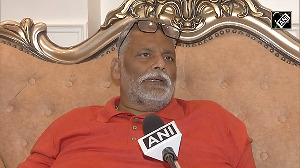"Shenzhou-VI will be blasted into space sometime next year," Zuo Saichun, a spokesperson of the China Aerospace Science and Technology (CAST), told China Daily. "The spacecraft will make new breakthroughs in China's manned space technology."
China's space authorities gave the first official statement and details of China's next space adventure ahead of the Fifth Airshow in Zhuhai in Guangdong Province in south China.
Unlike Shenzhou-V, which flew with a single astronaut for 21 hours and 30 minutes in October last year, the next flight will see two astronauts fly in space for five days.
The capsule will be capable of orbiting for a whole week, Zuo said.
"For the first time, astronauts will enter and live in the orbital module of the spacecraft to do scientific experiments," a statement from CAST, the major manufacturer of the manned spacecraft and its launch vehicle said.
About Shenzhou-VI, it said, scientists have optimized the spacecraft's configuration to reduce its weight, and tried to improve the performance of on-board equipment.
The scientists have worked to guarantee the energy supply of the spacecraft and further improve its reliability and safety. They have also worked out solutions to problems pertaining to environmental control and life support.
Shenzhou-VI will be sent into orbit atop a Long March 2F carrier rocket. It contains three modules for propelling, orbiting and re-entry.
China only third nation to put man in space
China would display a model of the Chang'e-I satellite, which is expected to be sent to orbit the moon in two years at the Airshow. The satellite, part of the three-stage programme, would be followed by the landing of an unmanned vehicle on the moon in the second stage by 2010 and collecting samples of lunar soil by 2020 in the final stage.
In addition to obtaining a three-dimensional image of the lunar surface, Chang'e-I will also analyse the content and distribution of useful elements on the moon surface, measure the density of lunar soil and explore space between the earth and the moon, the report said.





